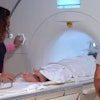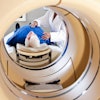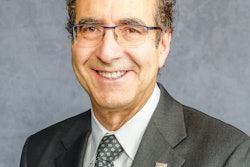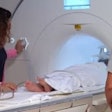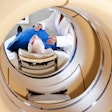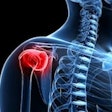Radiology’s evolution is dependent on the amount of change the field willingly makes for new technologies and applications. And while such change is tough, it’s needed for the field to further progress.
That was the takeaway from the RSNA president’s address held November 26, with association president Matthew Mauro, MD, encouraging attendees to embrace the new and learn to recognize when significant change is among them.
 RSNA President Matthew Mauro, MD, issues the president's address at the association's 2023 annual meeting. Mauro encouraged radiology leaders to be open to change for the field to grow and progress into a tech-filled future.Amerigo Allegretto
RSNA President Matthew Mauro, MD, issues the president's address at the association's 2023 annual meeting. Mauro encouraged radiology leaders to be open to change for the field to grow and progress into a tech-filled future.Amerigo Allegretto
“Change is essential. It is the driver of growth,” Mauro said. “The manner in which we embrace and adapt to that change will ultimately determine our success in the future.”
In healthcare, changes are being experienced in terms of technological advancements and approaching patient care. Mauro said these include payment models, patient expectations, delivery systems, competition, and an unstable labor market. The COVID-19 pandemic meanwhile exacerbated such change, but Mauro said radiology has emerged from the other side wiser and more secure that the field will thrive.
“Radiology has always been a force for change in medicine, revolutionizing diagnostic imaging studies, innovating minimally invasive procedures, and pioneering therapies for cancer,” Mauro said. “With innovation as a cornerstone of radiology, we are well-positioned to accept the necessity of change to continue to advance our profession.”
Inflection Point Recognition
So with that being said, how can radiology leaders tell if significant change is about to happen or is currently happening? Mauro said it’s important for leaders to assess their surrounding environment and identify affecting forces.
This includes exploring the competency of existing competitors, customers, potential competitors, suppliers, complimenters, and regulators. This means considering the possibility that the service provided can be delivered in a different way.
This brings it all to the strategic inflection point, which occurs when the balance of forces shifts from the old ways to competing and succeeding to the new ways. While it may be difficult to tell when or how long an inflection point may occur or last, Mauro said that it is helpful to scan the competitive environment and prepare for multiple scenarios.
One example he used was the evolution of interventional radiology, which used to be strictly referral-based. However, Mauro said that the power of future competitors has arisen, such as cardiologists, vascular surgeons, and interventional nephrologists. This means that the referrers have become the competitors.
Mauro said this has led to interventional radiology becoming a prioritized focus in training curriculums.
“You need to ask yourself … is your key competitor about to change?” he said. “Is the service you provide being delivered in a different way? Are you willing to do what it takes to beat the competition? Are your key people struggling?”
What leadership can do
By committing to a clear vision, radiology leaders will come out of change successfully, Mauro said. This means developing a functional and cohesive team with the following steps: building trust, mastering conflict, embracing accountability, and focusing on results.
“Status and ego cannot get in the way of success,” Mauro said.
However, he added that transformation is a process rather than a single event. This means that it could take years to see meaningful results, with planning, patience, and perseverance needed.
Mauro also said that this means creating a clear vision, offering an easy-to-see picture for governing bodies and leadership’s people, as well as creating short-term wins.
“Your team members should be emboldened to try new approaches and to experiment,” he added.
Mauro also said that this means promoting people into leadership positions who embody the new approaches, as well as developing leadership succession planning that is consistent with new models.
How to embrace AI
Mauro said that the adoption of new technologies is a critical component of radiologists’ success. He called for radiology leaders to advocate for these new technologies to be adopted early into mainstream medicine.
“Professional societies like the RSNA, and the resources, education, and networking opportunities they offer, are vastly helpful in reading the landscape,” Mauro said.
He also said that while current imaging technologies are powerful, AI’s influence continues to grow within radiology departments. Mauro said that when it comes to AI and other new technologies, radiology leaders can either accept and adopt them or be left behind. But that doesn’t mean the future is bleak for radiologists.
“AI will open new doors for us,” Mauro said. “As AI applications continue to improve, they will be able to absorb or assist with a host of tasks, from scheduling to reporting to triaging imaging studies, freeing the radiologists to devote their time to the more enriching aspects of our work.”

